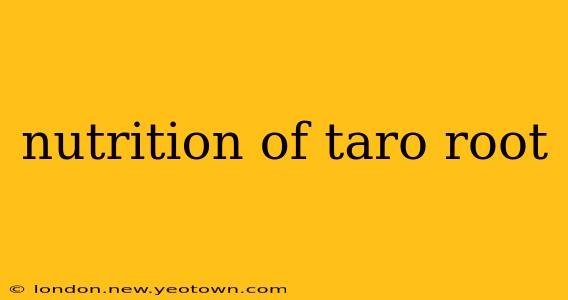Taro root, a starchy tuber with a history as rich and varied as its flavor profile, has quietly earned its place as a nutritional powerhouse. From the lush landscapes of Polynesia to the bustling markets of Asia, this humble root vegetable has sustained communities for millennia, and its nutritional benefits are finally gaining well-deserved recognition in the modern world. But what exactly makes taro so special? Let's delve into the fascinating world of taro root nutrition.
What are the Nutritional Benefits of Taro?
Taro's nutritional profile is impressive, boasting a significant amount of carbohydrates providing sustained energy, along with a decent supply of essential vitamins and minerals. It's a good source of fiber, which aids digestion and promotes gut health. Beyond these basics, it's the unique blend of nutrients that sets taro apart. We'll explore this in more detail below.
Is Taro Root Good for Weight Loss?
This is a question often asked. While taro is a carbohydrate-rich food, it’s important to understand the type of carbohydrate. Taro contains resistant starch, a type of starch that resists digestion in the small intestine. This means it's slowly digested and absorbed, leading to a more gradual and sustained release of energy, preventing blood sugar spikes. Furthermore, the fiber content contributes to satiety, helping you feel fuller for longer. Therefore, while not a miracle weight-loss food, taro can be part of a balanced diet supporting weight management goals when consumed in moderation.
What are the Health Benefits of Taro?
The benefits of taro extend far beyond weight management. Its rich nutrient profile contributes to overall health and well-being in several ways:
- Improved Digestion: The high fiber content promotes regular bowel movements and supports a healthy gut microbiome.
- Enhanced Energy Levels: The complex carbohydrates provide sustained energy release, preventing energy crashes.
- Stronger Immunity: Taro contains Vitamin C, an antioxidant that strengthens the immune system and protects against cell damage.
- Healthy Skin and Hair: The presence of Vitamin E contributes to healthy skin and hair.
- Bone Health: Taro contains calcium and other minerals beneficial for bone health.
What are the potential side effects of eating taro?
While generally safe, excessive consumption of taro can lead to digestive issues due to its high fiber content. Some individuals may also experience allergic reactions, ranging from mild skin irritation to more serious symptoms. It's important to note that raw taro contains calcium oxalate crystals which can cause irritation in the mouth and throat. Always cook taro thoroughly before consumption.
How much Taro should I eat per day?
There's no single recommended daily amount of taro. Incorporating it as part of a balanced and varied diet is key. Moderation is advisable, particularly if you have pre-existing digestive issues. Listen to your body and adjust your intake accordingly.
What is the best way to prepare Taro?
Taro can be prepared in a variety of ways. Boiling, steaming, baking, or frying are all common methods. It can be mashed, pureed, or added to soups, stews, and other dishes. The possibilities are truly endless, making it a versatile ingredient in many cuisines.
Conclusion: Embracing the Taro Root
Taro root, with its unique blend of nutrients and versatile culinary applications, deserves a prominent place in a healthy and balanced diet. From its contribution to digestive health to its sustained energy release, taro offers a wealth of benefits for those seeking to improve their overall well-being. While always remembering to cook it thoroughly and consume it in moderation, you can discover the delightful taste and significant nutritional advantages this remarkable root vegetable has to offer.

